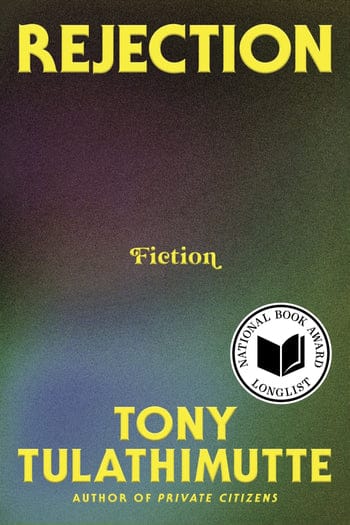DNF: Rejection by Tony Tulathimutte

I made it two stories into Rejection before I returned it to the library. Reviewers whose writing I like and whose taste I trust loved the latest book from Tony Tulathimutte, and its exploration of rejection sounded deep and thought-provoking while being funny and sharp. I think those reviewers were right, and I think all of this is evident in the book. I just didn’t like it. So I Did Not Finish (DNF) this one.
After reading and appreciating but not enjoying the first two stories, I started on the third. That’s when a small voice in my head said, Oh, this is cringe, and cringe is not for me. My brain is not wired for cringe entertainment – not cringe literature, cringe comedy, cringe TV, none of it.
In the 2000s, “cringe” came to mean secondhand embarrassment, usually for the entertainment of the audience. The Office could be cringe, tweets could be cringe, stand-up routines could be cringe. A subreddit devoted to cringe popped up with the tag line “When it just hurts to watch,” and it’s still got more than a million members. Cringe works on empathy, the feeling that but for the grace of god, the person in the video or on the stage could very easily be you. You feel a kind of solidarity with the person being cringe while also being so very relieved that it is not, in fact, you saying and doing these things.
If you like or at least tolerate cringe, Rejection is a good book, and even funny. It succeeds at doing what Tulathimutte set out to do. He’s very good at digging in to the characters and making the reader swing from “Oh, honey, no” to “Oh, hell no” as they experience rejection and make choices, usually terrible ones. His use of a deteriorating group text as one woman becomes more and more unhinged after being ghosted by a friend she slept with is one of the best uses of texting in a novel I’ve ever seen.
Once I’d decided not to go on with Rejection, I went looking for reviews that felt the same way I did, or at least were less than glowing. I was hoping to see someone else put into words the way I was thinking about the book. There really weren’t any. People love this book and relish the discomfort of the rejected characters. A lot of people like cringe.
But while I was searching, I found this brilliant essay on rejection that Tulathimutte wrote for The Paris Review in the run-up to the publication of the book. The essay is not cringe; it is well-researched and wide-reaching, and it made plain what a thoughtful writer he is. The opening sentence lays out his thesis:
Rejection may be universal, but as plots go, it’s second-rate—all buildup and no closure, an inherent letdown.
His ability to turn story expectations inside-out to achieve his ends with the “second-rate” rejection plot, and his deep consideration of exactly what he is doing with Rejection, is how I know that it’s a good book even though I did not like reading it.
Tulathimutte’s essay makes clear his wide range of literary references, mentioning Proust, Dickens, Pygmalion, Austin, Arendt, and Miss Manners as well as an fMRI study and social science research. He also close reads an illustrative 2chan narrative with high engagement and, unsurprisingly, dubious provenance. He notes how the 2chan poster crafts his messages to preempt rejection, and he preempts my own DNF later in the essay: “There is one other surefire way to end a story that doesn’t progress, and that is to stop reading it (or writing it).” Tulathimutte found fertile ground in his rejection plots, and he did not stop writing them. I, however, did stop reading them.
While I was not reading, I happened to watch Penelope Spheeris’s documentary Decline of Western Civilization Part 1, which reminded me that in college, I was obsessed with her film Suburbia. I honestly cannot recommend that anyone watch it in 2025; content warnings abound for sexual assault, Nazi regalia worn (mostly, and uselessly) ironically, I think some child abuse, and probably more that I’m not remembering right now. The punk protagonists all squat in an abandoned tract house they call the TR House, for “The Rejected.” I was so into the movie that I sewed a TR armband onto my thrifted navy blue jacked; it might have been part of an old mail carrier's uniform. But I can still hear the clueless dad in the movie saying, “What is TR, anyway?”
There are some ways in which I was rejected when I was younger, but it wasn’t a main event in my life. I hung out with a punk rock crowd, and they didn’t reject me. I met my partner in that crowd, and we’ve been together for decades. I’m close to my family of origin and of choice, and my friends. Even my cats don’t reject me too often. Yet I somehow latched onto The Rejected as a young adult.
Maybe rejection is a mantle a lot of us wear for a while, an armband on our metaphorical jackets while we navigate a sea of massive change. In the years since retiring my TR jacket, I’ve been actually rejected a bunch of times. I’ve lost jobs and gigs, I’ve had friends fade away, I’ve received dozens of posted and emailed rejections—they're just called rejections, no euphemistic language here—from editors and agents and publishers. Being a freelancer and an author is basically asking for rejection on a regular basis and getting used to it on some level. But I didn’t feel like The Rejected in the same way through all these years; I didn’t wear it on my sleeve. I chalked it up to the human experience.
The characters in the two stories I read in Rejection didn’t chalk it up in any way. But they also weren’t sewing it on an armband or finding their fellow rejects. Punk made being rejected by society, or rejecting society, fun. Rejection makes it seem … not fun. Rejection also seems – from what I read – to be entirely about romantic rejection, not familial or societal or authorial or educational or any of the other rejections humans experience. Those stories could very well make up the other two-thirds of the book. If you've read it all the way through and know I missed those, tell me and other readers in the comments on this post.
Here I am, hundreds of words into a sort-of review of a book I did not finish, and I can only laugh at myself for using an elaborate essay about a DNF when I could use the language provided by our culture to those who reject others:
Rejectors have their prefab lines ("It's not you, it's me," "I'm not dating right now," "We're not a good match"), but rejects don't. What is there to say, after all?
At least two out of three of those lines from the Paris Review essay apply. It's not Rejection, it's me.
KHG’s latest translations, Memoirs of a French Courtesan Volume 1: Rebellion and Volume 2: Spectacle are available now. Volume 3: Luck coming May 2025!
All links to Bookshop.org are affiliate links that help keep The Wingback Workshop working. Thank you for your support!
